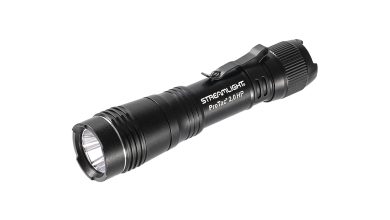Review: Wilson Combat P1
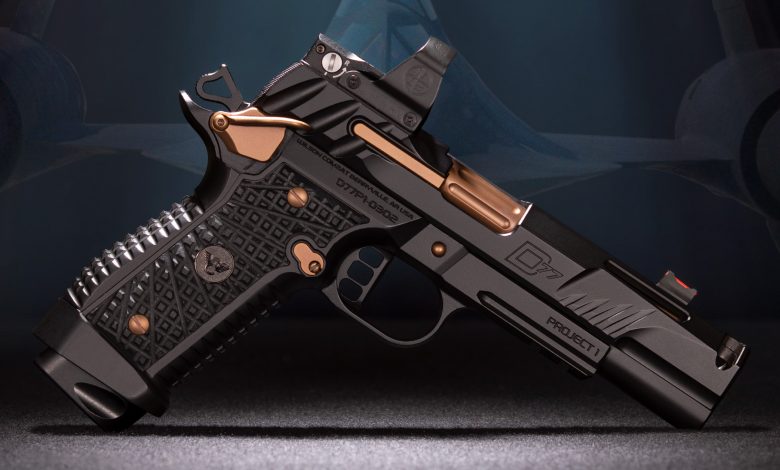
Wilson Combat has created a new division within the company that has three primary goals: The first is to showcase what Wilson Combat’s R&D division is capable of, the second is to thrust the manufacturer to the forefront regarding innovation, while the third is to provide consumers with superbly engineered firearms in a limited-edition capacity. The company refers to this segment of its immense operation as “Division 77,” and the first Division 77 project is called the “P1.” From a performance and user-interface standpoint, this just might be the most advanced 1911-style pistol ever crafted.
Roughly 50 years ago, a jeweler in Berryville, AR, began customizing 1911 handguns, because as a competitive shooter, he was unsatisfied with what was available. The pistols he modified became revered. He was also savvy enough to start offering custom 1911 parts with which other builders could work, and 1911 magazines—that worked—for shooters to trust. That man was Bill Wilson, and the company he founded in 1977 is arguably the largest custom-firearm manufacturer in the world. Cam Ankle, who currently heads up the company, created Division 77 to honor and reflect the same innovation Wilson originally pioneered, but for it to also work as sort of a Skunk Works-like segment of the company to lead the industry.
I’ve spent several months working with the new P1, and if it’s representative of what we can expect from the company’s new Division 77, every other gunmaker is going to be chasing Wilson Combat. The P1 is the largest-capacity, softest and most precise shooting, and most versatile 1911 I have ever fired. So, let’s look at exactly what makes it so special.
Generous, uniquely shaped rear slide serrations provide ample purchase while being as aesthetically pleasing as the P1’s two-tone finish • While devoid of dots, the drift-adjustable, serrated, solid-black rear assembly is paired with a bright red fiber-optic post that quickly draws the eye • Chamfered edges surrounding the front cocking serrations offer additional purchase when cycling the slide • The P1 comes with three 18-round magazines, providing more than 50 rounds at the ready • Fine 30 lpi checkering spans the top of the pistol’s slide to aid in glare reduction.
Let’s begin with the handgun on which the P1 is based, the 1911. In 2017 the company substantially advanced the 1911 design with its EDC X9 pistol. Further, it designed the EDC X9 around the 9 mm cartridge to be the ultimate carry gun. Its most relevant features were its double-stack, increased-capacity magazine and the absence of the iconic 1911 grip safety many shooters hate. After evaluating an EDC X9, I bought one, and it’s been my primary self-defense pistol ever since. Last year, Wilson Combat introduced a 2.0 version of the EDC X9 with interchangeable grip panels, and that’s the genesis of the Division 77 P1.
With the P1, Wilson Combat wanted to further elevate the 1911 in several ways. First, it wanted to substantially reduce recoil, so the pistol was more comfortable and faster to shoot. Second, it wanted to fully transition the platform into the new world of reflex-optic compatibility. It also wanted it to be fast to reload and easy to dissemble, but with flawless reliability and enhanced precision on target. That’s a pie-in-the-sky wish list, but from what I can tell, the manufacturer achieved every goal.
Starting with a 5-inch EDC X9 2.0, to reduce recoil Wilson Combat created a multi-port compensator integral to the barrel with matching ports in the slide. But, the Division 77 crew did not just put holes in a barrel and hope it reduced recoil. To perfect recoil compensation, it turned to one of the company’s engineers: Jamie Wright, who is a wiz at data collection and analysis. As it turned out, Wright designed a complex and proprietary recoil-calibration device that collects 2,000 pressure data points within a 350-millisecond window. It essentially creates a mathematical video of the recoil event. By using this device, Wilson Combat was able to tune the P1 to reduce recoil by more than 40 percent. Not only is that groundbreaking, it also makes the P1 the lightest-recoiling 9 mm 1911 ever made.
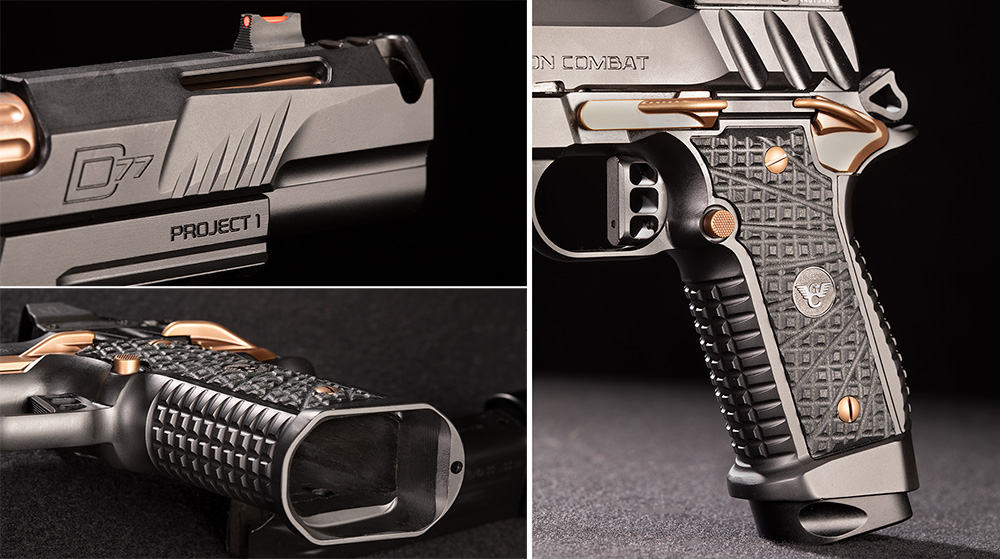
The addition of a wide-mouth magazine well helps facilitate faster reloads • Lightening cuts flank the pistol’s front-sight assembly and offer eye- catching flair, while simultaneously shaving precious ounces, shortening lock time—a vital element for a competition pistol • G10 Trak texturing on the frontstrap, backstrap and sides of the P1 provides a non-slip grip.
To make the P1 compatible with the widest array of miniature reflex sights—without mounting plates—Division 77 engineers came up with a brilliant solution. For starters, they machined a flat section on the top of the slide behind the ejection port. Then, they drilled and tapped the slide, but most importantly, they machined shallow circular recesses in this flat section that will accept miniature disks corresponding to various optic-mounting footprints. Wilson Combat is calling this system “P1 Pin Technology,” and by swapping out these pins/disks, you can direct-mount any reflex sight with an RMR, RMSc or DeltaPoint Pro footprint directly to the P1’s slide. For the accuracy-testing portion of this review, I opted to install a Leupold DeltaPoint Pro.
Alternatively, consumers can mount the rear-sight plate with its Wilson Combat Battlesight to the P1. Uniquely, this rear-sight plate is screwed in place, and the firing-pin retaining plate is integral to the sight plate. It pairs nicely with the interchangeable fiber-optic front sight. If you’re running an optic, you can replace the fiber-optic front sight with a low-profile blade, but this pistol isn’t intended to provide a co-witnessing option. Wilson Combat wanted to make the P1 either a dedicated optic or open-sight gun, and with it the company has fully committed to the future—a future unquestionably tethered to the reflex sight. Therefore, your choice is optics or irons, but not both.
To make reloading faster and easier, the Division 77 staff crafted a wide-mouth magazine well integral to the frame. Just about all you need to do to rapidly reload the P1 with one of the three 18-round magazines—fitted with oversize Project 1 aluminum base pads—that come with it is just get it started in the right direction. The wide-mouth mag well seemingly sucks the magazine inside.
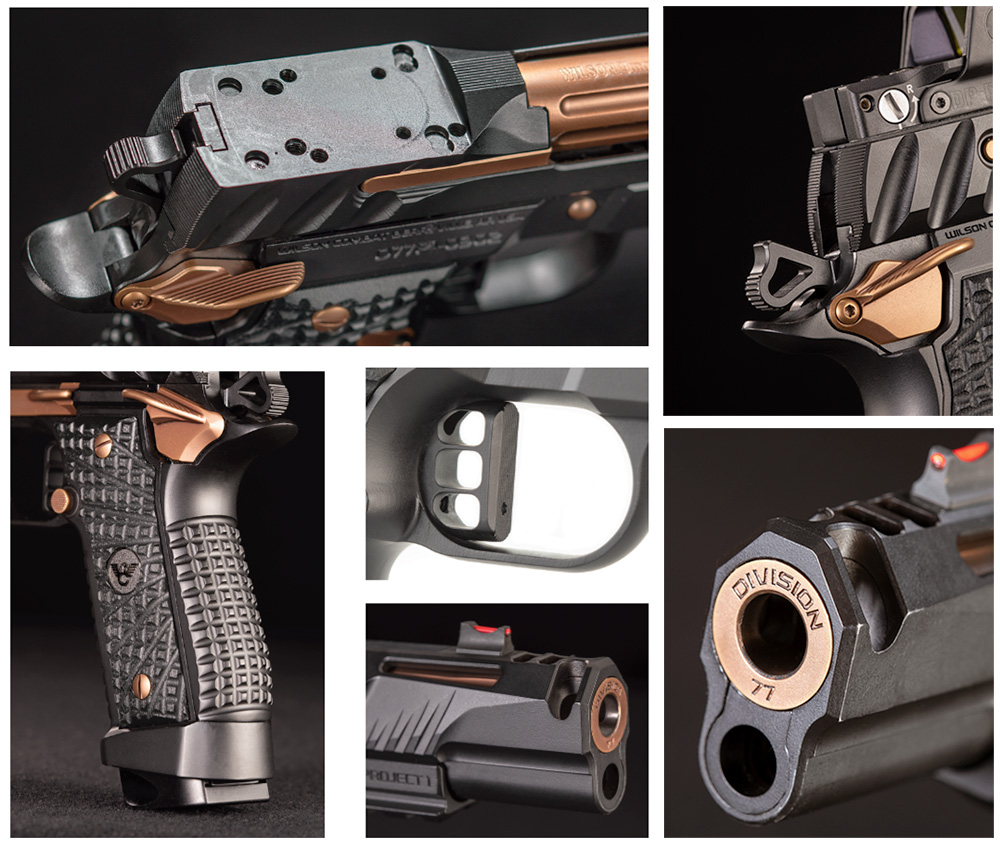
Division 77’s pin technology offers a new approach of mount- ing a wide variety of micro red-dot sights directly to the P1 • In addition to featuring skeletonized components, the P1 boasts ambidextrous fire controls for left- and right-handed shooters • One need look no further than the rollmark at the end of the P1’s bull barrel to know it’s a handgun of truly unique lineage • Grippy texturing combined with a high backstrap contribute to the P1’s excellent ergonomics, while its long, flat-faced trigger serves as key component to its shootability • An enormous amount of R&D went into creating the pistol’s full-contour, multi-ported compensator, which is one reason why it may be the softest-recoiling 9 mm produced to date.
To simplify fieldstripping, Wilson Combat also crafted what it’s calling the “RPG” guide rod and paired it with a fully supported bull-barrel reverse plug. Except for the absence of a barrel bushing, you disassemble and reassemble a P1 just like you would any common 1911. And finally, to improve reliability, the P1 also uses reliability-enhancing frame rails.
To maximize user interface, the P1’s front and rear grip straps feature Wilson Combat’s unique Trak system. At 5 lpi, you could call this magnified checkering. It’s grippy as hell, but does not bite into your hand like the sharp 20- or 30-lpi checkering so common on traditional custom 1911 pistols. Since the P1 is based on the EDC X9 2.0, it also has interchangeable grip panels, and it ships with black G10 Trak Starburst grips with black medallions. However, unlike the common EDC X9 pistols, the cocking serrations on the slide are deep, radiused cuts, and the bottom edges of the slide have a heavy machine chamfer. This pistol is smooth where is needs to be, and grippy where it should be.
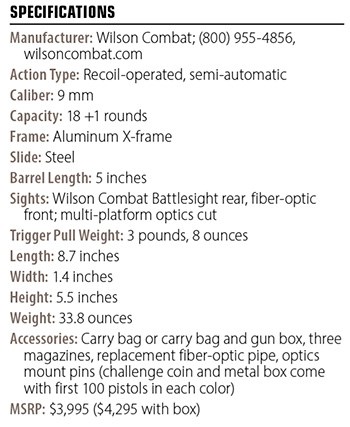 Another noteworthy element of shooter interface on the P1 is the trigger. The pistol ships with a long, skeletonized, flat-face trigger, and according to my scale, sear release occurred at right at 3.5 pounds. That’s about standard for a finely crafted 1911 pistol, but what impressed me the most was the clean break, lack of overtravel and the incredibly short trigger reset. All you really need to do to reset the P1’s trigger during recoil is think about it; it is almost like it occurs in a video-game-like natural kind of way.
Another noteworthy element of shooter interface on the P1 is the trigger. The pistol ships with a long, skeletonized, flat-face trigger, and according to my scale, sear release occurred at right at 3.5 pounds. That’s about standard for a finely crafted 1911 pistol, but what impressed me the most was the clean break, lack of overtravel and the incredibly short trigger reset. All you really need to do to reset the P1’s trigger during recoil is think about it; it is almost like it occurs in a video-game-like natural kind of way.
When it comes to pistols for self-defense, competition or even recreational shooting, performance matters most, but it’s not everything—shooters like guns that look as good as they shoot. The P1 is a striking pistol. It’s finished in black Armor-Tuff, but has a brilliantly contrasting and attractive copper PVD finish on the barrel, barrel link, barrel-link pin, slide stop, magazine release, grip screws, ambidextrous thumb safety and thumb-safety screw. It also looks damned serious, like something a high-speed, low-drag operator use in an action movie.
From a sandbag rest at 15 yards, sub-inch, five-shot groups were not a problem, and Wilson Combat offers a sub-inch guarantee at 25 yards. What’s more, like a famished hog inhales table scraps, the P1 hungrily consumed every load option I fed it. This pistol is unquestionably the softest and most accurate-shooting 9 mm 1911 pistol I’ve every fired. With it, I turned in some of my best times and targets on the several standard test drills I use to evaluate pistols. I’m confident in saying that Wilson Combat has raised the bar when it comes to the 1911, and I sincerely hope some of P1’s enhancements will ultimately make it into the standard Wilson Combat product line.
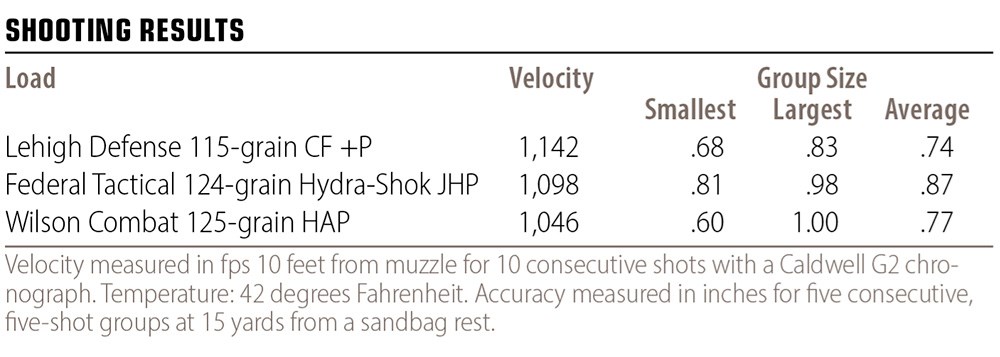
But, there’s a little more to this story. As with all upcoming Division 77 projects, the P1 is offered in limited quantities. The fancy black-and-copper version is the first, but other color options will be announced later in 2025. With them all, the first 100 of each color variation will come with a custom metal and magnetized box that holds the pistol, open sight plate, three magazines and necessary optics pins. Finally, the second project from Division 77 is already underway, but my inside source inside refused to divulge any details. We’ll just have to wait until around late 2025 to see what kind of wonderfulness it will be. Keep in mind, Wilson Combat does not intend these subsequent projects to be enhancements of a previous project; they’re unique and intended problem to solve or innovate in different areas even with other various firearm platforms.
The P1 represents a significant advancement in 1911 pistols, seamlessly combining innovation, performance and aesthetic appeal. With it—and the newly established Division 77—I believe it is certainly safe to say Wilson Combat has again made itself stand out as the pinnacle source for the evolutionary 1911 pistol.
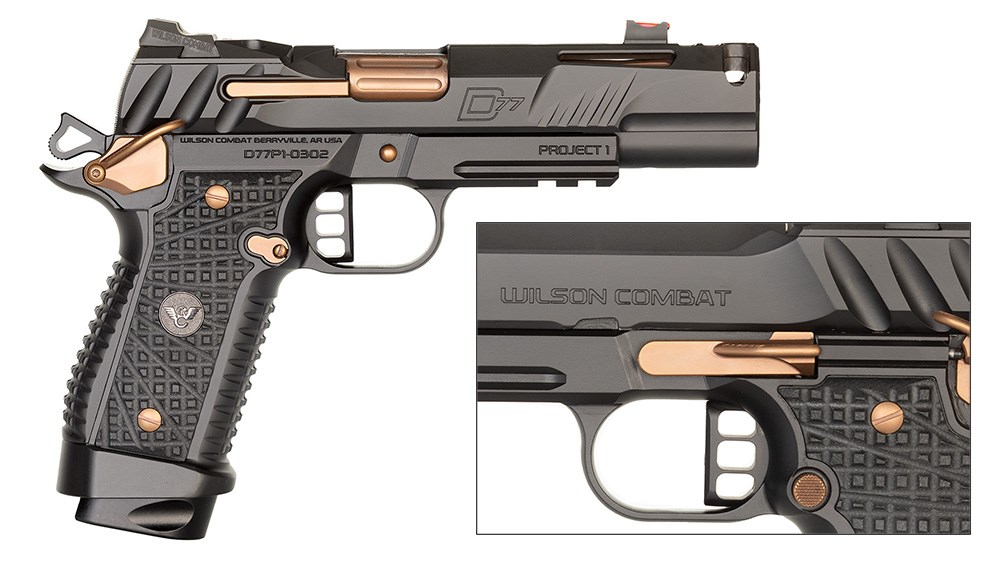
Read the full article here







